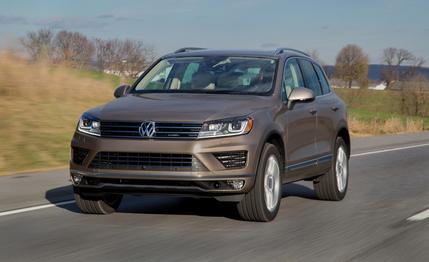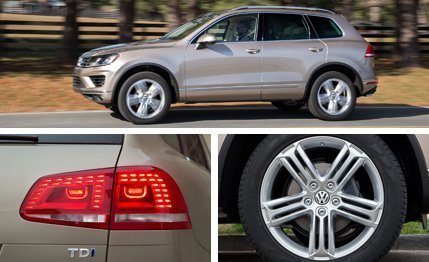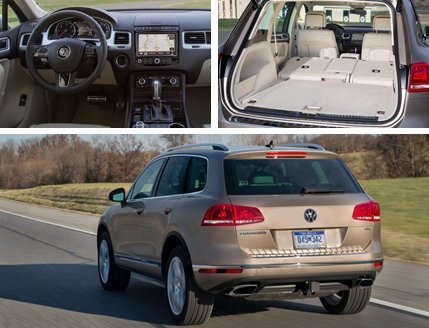 First Drive Review
First Drive Review
For a vehicle named after a tribe of Saharan nomads, the Volkswagen Touareg (pronounced “twar-egg”) hasn’t wandered far from the middle of the road. That’s been good business for VW, which says it has sold more than 720,000 copies of this mid-size SUV worldwide over 11 model years now, nearly 130,000 of them in the U.S. So VW didn’t see much need to go wandering off into the desert with this midterm update for 2015. The Touareg is one of our Editors’ Choice picks, and the 2013 TDI model won a comparison test of diesel SUVs, so we’d agree that not much needed to be fixed.
This second-generation Touareg debuted in 2011, and this newest one is mechanically unchanged whether you choose the standard gasoline V-6 model, the TDI turbo-diesel, or the performance-oriented hybrid. The exterior is dressed up with a new four-bar grille, chrome trim, lighting upgrades, restyled wheels, and new colors. Inside, there’s more shiny silver stuff, better switchgear, and richer-looking leather and wood trim details. Finally, to stay in contention with newer competitors, VW added a suite of electronic driver safety aids including adaptive cruise control, a lane-departure warning system, blind-spot detection, and pre-collision braking.
Standard 4MOTION all-wheel drive, a rated towing capacity of 7716 pounds, more than six inches of fore/aft travel for the split-folding rear seat, and a hands-free liftgate for access to the cargo hold (32 cubic feet with the seat up or double that with it folded) all carry over as allures to those buyers who still need real SUV features and won’t settle for less-capable crossovers.

Our first experience driving the 2015 model was much like our last drive in a 2014 Touareg. This went double because VW staged its media event minutes from C/D’s Ann Arbor offices, using a route incorporating roads we use regularly for our 10Best testing. As you’d expect, the driving character of both the gasoline FSI and diesel TDI V-6 variants carries over with good feel from the hydraulically assisted steering (only the hybrid uses electric assist), a fairly taut and responsive chassis, and a nicely firm and readily modulated brake pedal. The family-oriented VW’s character tilts toward the compliant and comfortable mainstream virtues, leaving more expressive driver-oriented attributes to its VW Group platform-mates, the Audi Q7 and the Porsche Cayenne. The VW, for instance, doesn’t offer paddle shifters for its eight-speed automatic transmission, although there’s a manual mode available on the shift lever.
The manual mode is semi-necessary to keep the 3.6-liter FSI V-6 on the boil to propel 2.5 tons of mass. Programming for the transmission is fairly prompt to kick down when the driver pushes hard on the accelerator and smart about holding gears through a series of bends, but it’s also calibrated to maximize economy on the EPA cycle. As has been the case at least since the diesel’s horsepower total was bumped to 240 (from 225) in 2013, the TDI version’s abundance of torque (406 lb-ft) makes it the driver’s choice when accelerating out of slow corners. The penalties for diesel are minimal here, with only a very slight coarseness in the power delivery to give away the game, plus the buy-in cost and the pricier fuel that offset the real fuel-economy advantage. The higher peak output of the gas engine is evident only in passing maneuvers at higher speeds. Yet the real performer of the range is still the costly hybrid, which enjoys a huge power advantage over its siblings.
We regard the new safety-technology features much as we do the exterior chrome: Superfluous steps that keep the Touareg competitive with newer offerings in the segment without really adding much desirability. The lane-departure warning comes in the form of a vibration in the steering wheel, adjustable via the central touch screen through three degrees of severity. At its gentlest, we found the warning that we’d crossed a lane line without signaling our intentions nearly indistinguishable from the vibration induced by slightly roughened pavement and less so than the edge-warning grooves on some highways. The harshest setting should be reserved for the chronically inattentive, who might well imagine the shaking wheel as indication they’d just run over an alligator.

The adaptive cruise control works well and, with the pre-collision braking feature, can bring the Touareg to a full stop when traffic demands. The blind-spot warning, delivered via lights on the inner edge of the exterior mirror housings, worked as advertised but never told us anything we didn’t already know by paying attention to properly adjusted mirrors. The lights glow to indicate the presence of a vehicle in an adjacent lane, flashing if the driver signals a lane change in that circumstance or with traffic fast approaching (VW calls this latter feature Side Assist). The main reason VW needs these “aids” is to keep shoppers who insist on them from wandering off to other brands.
Buyers can opt for some of these technologies on Touaregs starting in the mid-$40,000 range, but the diesel isn’t available until the price starts with a five. The base model is the Sport, followed by Sport w/Technology that adds navigation, a towing package, and Side Assist. This level is the lowest trim for the diesel, which costs $3500 more than the FSI engine, a margin that carries through the mid-level Lux (with Park Distance Control) and top Executive (with surround-view camera) trim levels. The hybrid partially justifies its exorbitant MSRP by including all the new driver assists, some of which are optional even at the Executive level, as standard equipment.
Jeep sells almost twice as many Grand Cherokees in any given month as VW sold Touaregs all last year, and VW’s mild update doesn’t offer any compelling argument to drastically move the scales, but it should keep this appealing SUV on shopping lists for a few more years